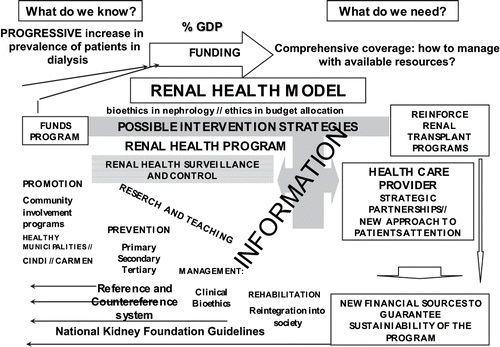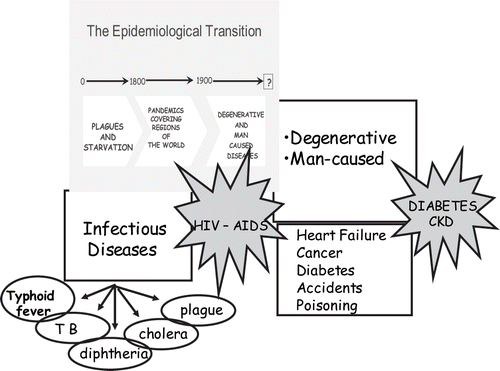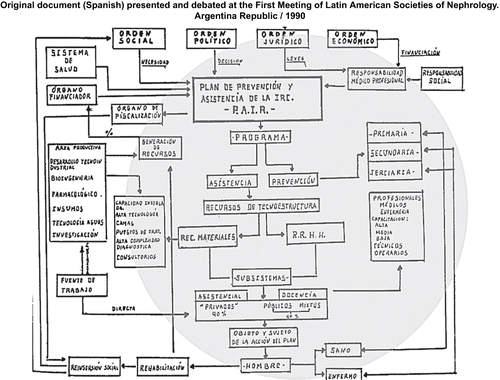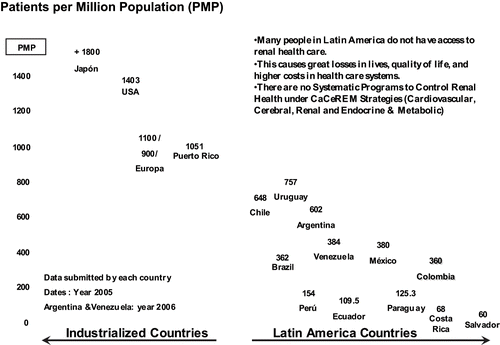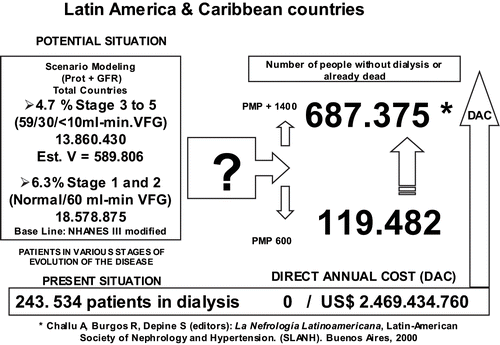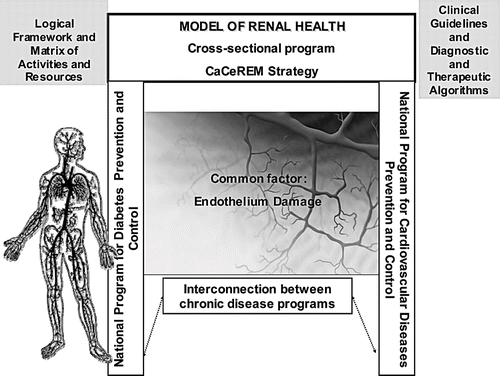Abstract
Purpose. To verify the actions and degree of progress achieved in countries of Latin America and the Caribbean in the implementation of the Sustainable and Tenable Renal Health Model promoted by the Latin American Society of Nephrology and Hypertension (SLANH), together with local societies and the participation of the Pan-American Health Organization. (PAHO/WHO). Method The implementation of workshops (e.g., “Toward a Sustainable and Tenable Renal Health Model”) in each country involving health ministries, social security agencies, PAHO, scientific societies, medical organizations, and NGOs, among others, as well as start-up conferences with a special emphasis on local problems. Working teams will state the bases for planning, programming and evaluation in the Logical Framework Matrix and Matrix of Activities and Resources in the First Level of Care. The signature of the document “Declaration” with commitments undertaken by both public and private parties and a work schedule are required. Results. So far, eleven countries in the region have conducted workshops and started activity in the frame of the Model/Program of Renal Health, which articulates the traditional vertical programs and generates a cross-program in the First Level of Care. Its components and strategies make up a cost-efficient control of cardiovascular, renal and endocrine-metabolic health. Conclusion. The Renal Health Model and its program is being built into public health care policies of countries in Latin America and the Caribbean and adapted to the needs of each country with an increasing acceptance on the part of health care professionals. It should not be implemented in isolation but within the framework of non transmissible diseases.
INTRODUCTION
The progress of medicine through the centuries is helping us enjoy great advances contributed by scientific knowledge and an almost boundless development of pharmacology and biotechnological research—so much so that they need the help of bioethics. Conversely, there is a growth of inequality and a widening of the gap between developed and underdeveloped countries. In the latter, most of the population lives below the poverty line, as is often the case in Latin America and the Caribbean.
Furthermore, the growing increase in technological costs and the rise of demand, generally associated to inefficient budget policies, have caused global health care expenses to rocket to the point of jeopardizing national economies.
In this context, and to determine its impact on society, one needs to go beyond the biomedical paradigm that prevails both in the medical science and in popular culture and promote a bio-ethic-psycho-social-economic-spiritual understanding of man.
Teaching models must be oriented to attain and maintain the quality of living, strengthening the quality of knowledge and practices centered in doctor-patient, doctor-family, and health care team-community relationships, in the context of a new symbiosis between public health and clinical practices.
In this context, the Renal Health Model has been developed and is being implemented in a joint effort with National Societies of Nephrology and all the players in cardiovascular, renal and endocrine-metabolic health care, especially Primary Health Care teams and the First Level of Care. Their actions in the Health Care System must ensure quality, efficiency, and especially equality, so that each person has the best access possible to health and health care.Citation[1] Being a model does not imply a one-on-one relationship between components, but enables each country to adapt it to its needs.
MATERIALS AND METHODS
The authors follow the theory of Epidemiological Transition to describe health problems past and present. Actions taken in Latin America by the Societies of Nephrology and the relevant role of SLANH and its Committee for the Development of Nephrology and National Problems, Subcommittees of Data and Renal Health have been studied, and the baseline was the data provided by the Nephrology Survey in Latin America.Citation[2]
The authors prepared planning, programming, and the bases for the evaluation of the Renal Health ModelCitation[3] (see ) in the Logical Framework MatrixCitation[4] and the Matrix of Allocation of Activities and Resources,Citation[5] including strategies for:
strengthening transplant programs
service providers networks
background program, based on ethical principles of budget macro allocation
Renal Health Program
information database
One or more workshops was conducted in each country, for debate, consensus, and startup of the components of the model.
The authors promoted an action planCitation[6] to be used as a guideline for local implementation in each country, which involves (per the Declaration of Valdivia):
the creation of a patient identification system according to stage, and the recommendation of the use of NKF and Puerto Rico classification of chronic kidney disease.
the creation of a referral and counter-referral system, for orderly progress of renal patients along the path of primary health care.
the determination of goals and therapeutic plans, recommending the use of diagnostic and therapeutic flowcharts and algorithms.
the integration of the Renal Health Model in the context of national health care policies in each country, using the tools of the logical framework and the Matrix of Allocation of Activities and Resources.
Workshops were conducted in Chile (Declaration of Valdivia, December 2002), Argentina (Declaration of Buenos Aires, April 2003), Mexico (First Joint Meeting SMN and IMIN, April 2006), Uruguay (Statement of Montevideo, April 2004), Paraguay (Declaration of Asunción, July 2004), Venezuela (Declaration of Caracas, July 2004), Colombia (Declaration of Bogotá, December 2004), Ecuador (Declaration of Guayaquil, April 2005), Puerto Rico (August 2005), Perú (September 2005), and Brazil (Letter Intention of Brasilia, February 2006).
Epidemiological Transition
The theory of Epidemiological Transition states that the first 1800 years of the Christian Era were the Age of Pest and Hunger. The following 100 years, up to 1900, are known as the Age of Retracted Pandemics. Both periods were dominated by infectious transmitted diseases, like typhoid, cholera, diphtheria, TB, and the Black Pest.Citation[7]
In 1900, one sees the onset of the age of degenerative, manmade diseases. Non-transmitted diseases, pushed by the aging of the population, a critical growth of cities, contamination of the environment, accidents, and intoxications added to technological advances, such as dialysis or organ transplants, that prolong the survival of chronic patients.
The transition, however, is not linear. In the 1980s, one saw the onset of the HIV/AIDS with an impact that forced the U.N. to take extraordinary control measures, the U.N.-AIDS program, with a Statement of CommitmentFootnote[8] that reads:
HIV-AIDS is a worldwide emergency and one of the most serious challenges to the life and dignity of the human being, as well as to the enjoyment of human rights, which undermines economic and social development all over the world and affects all levels of society: individual, family, community and nation.
Today, diabetes associated with permanent renal failure has become a pandemic and warns us about a new scenario, comparable to renal failure for a number of people affected and its exponential growth over a few years. Its impact on health and the economy of individuals, families, and society is so strong that many countries are envisioning coverage difficulties in the short term (see ).
Furthermore, medical evidence shows a close connection between diabetes, cardiovascular disease, and renal disease. They have a common factor: malfunction or injury of the vascular endothelium, requiring common cross-actions between the traditional vertical programs of public health care agencies. They also require that one embraces a holistic view and avoid patient segmentation on their initial complaint or the expertise of their attending physician.
Committee for the Development of Nephrology and National Problems of the National Society of Nephrology and Hypertension (SLANH): Subcommittees of Data and Renal Health
The nearest precedent for a joint action between societies of nephrology in Latin America was the First Meeting of Latin American Societies of Nephrology, held in Rosario, Argentina, in 1900.
These are the conclusions about nephrology practices in the region:Citation[9]
Deep social and economic crisis.
Serious deficits in medical and community education.
No prevention—not even a status of situation for kidney disease. There is consensus that attention has been focused solely on the treatment of renal complaints.
Variable incidence of renal pathologies from country to country. Acute nephropathies are associated with iatrogeny. Chronic diseases are similar, though prevalence varies between countries: DBT, HTA, and glomerulonephritis, and to a lesser extent, urinary infections, lithiasis, and TBC, among others.
Unanimous emphasis on the importance of actual integration of prevention and treatment of nephropathies in Latin America, preceded by joint programs by nephrologists and other specialists in each country.
The authors analyzed the proposal entitled “Plan to Assist Renal Failure (PAIR)” (Depine, S. Personal Communication; see ). This proposal highlights the importance of the detection of real demand as a trigger of health care policies, advocates shifting away from traditional models that focus on spontaneous and subsidized demand and not a supply of services, and sets up basic connections between health care actions and funding.
Four years later, in the context of the 9th Latin American Congress of Nephrology in San Juan de Puerto Rico, the Committee for the Development of Nephrology and National Problems was created, followed by the Subcommittees of Data and Renal Health.
Since then, activity has been growing:
In 1996, nine countries signed the “Statement of Puerto Rico” in San Juan de Puerto RicoCitation[10] on the “Prevention of Chronic Renal Disease and Promotion of Renal Health.” For the first time, the concept of Renal Health created by Puerto Rico was used.
In 1997, fourteen countries signed the “Declaration of Buenos Aires,” “toward a new Renal Health Model in Latin America and the Caribbean.”Citation[11]
In 1999, the SLANH carried out a survey on the status of nephrology and its impact on the renal health of its populations in the countries of the region. The results showed that objectives were not being attained and showed the need for a new approach.Citation[2]
In 2000, we held, in San Juan de Puerto Rico and Buenos Aires, respectively, two regional workshops to train on the use of epidemiological tools (EPI-INFO) aimed at a new model in renal health. Both workshops were attended by local representatives of the Ministries of Health, PAHO-WHO and the School of Public Health of the University of Puerto Rico.
In April 2002, in San José de Costa Rica, the committee approved the general guidelines for the planning, programming, execution, and evaluation of the Renal Health Model (see ), framed within the Matrix of Logical Framework (see ) and the Matrix of Allocation of Activities and Resources (see ).
Table 1 Programming in the Context of the Logical Framework: General Guidelines for a Renal Health Model—Examples by Program and Component
Table 2 Renal Health Program: General Conceptual Framework and Breakdown in Specific Projects (Examples)
Table 3 Matrix of Allocation of Activities and Physical Resources. Example: Legal Framework in Argentina
In December 2002, in Valdivia, Chile, the action planCitation[6] was approved as a guideline to facilitate the implementation of the Model in each country.
From then on, in each country, the Societies of Nephrology have interacted with national agencies of health and the local representation of PAHO=WHO to implement workshops for debate and consensus to start up the Model of Renal Health in their respective countries.
The baseline for each country was the observed prevalence of dialyzed patients per million inhabitants (see ), and the epidemiological impact was made visible through Models of Scenario Simulation with two different hypotheses (see ):
Scenario 1. Estimated number of potential proteinuria patients in any stage of glomerular filtration rate (NKF or Puerto Rico Classification).
Scenario 2. Number of people who would have died without dialysis, taking as baseline an expected prevalence of 600 patients per million inhabitants.
RESULTS
Workshops were conducted and specific actions were taken in each of the following countries.(see ): Chile, Argentina, Mexico, Uruguay, Paraguay, Venezuela, Colombia, Ecuador, Puerto Rico, Peru, and Brazil. As a follow-up, each country is implementing, within its own health care policies, the components of the Model, either as a whole or in part.
Table 4 Workshops and Declarations
Chile
The Chilean Health Ministry conducted a National Health Survey in 2003 with a significant sample of Chileans 17 or older. (Cristina E. Mezzano, S. Prevalencia de Enfermedad Renal Crónica en Chile, personal presentation.)
The Chilean Society of Nephrology and the Ministry of Health worked jointly in the creation of guidelines for primary care physicians to facilitate the detection and control of early stages of renal disease in a high-risk population.
Argentina
Argentina adopted in all its parts the action plan approved in the Declaration of Valdivia. The PAHO provided technical advice,Citation[12,], Citation[13] and the Argentine Society of Nephrology and the Confederation of Dialysis Associations of Argentina also cooperated.Citation[14] The Renal Health Program was included in the state agenda when it was published in the “Boletín Oficial” (Official Bulletin) on September 27, 2004.Citation[15]
The plan was implemented by the Administration of Special Programs of the Ministry of Health and the EnvironmentCitation[16] and features explicit financial incentives. It articulates the following strategies:
Special Funding. Granted in the context of the Reciprocal Redistribution Fund a specific budget item.
Strengthening of Transplant Programs. Financial coverage for procurement, transplant, and lifelong delivery of immuno-suppressor medication after transplant.
Networking of Service Providers. Networks of primary care physicians and specialists, in the First Level of Care, with halfway control nodes for early detection of the need for training and education of human resources.
Renal Health Program. “Control” program that articulates the promotion, prevention, treatment, rehabilitation, research and education, and generates activities and resources to be shared by vertical programs of cardiovascular, renal, and endocrine-metabolic health. Economic incentives for the agents of the Health Insurance System.
Financing of promotion and dissemination.
Subsidization of epidemiological strategies (screening) that coexists with the one for risk groups (control in the health care system).
Funder reimbursement of dialysis fees for patients who have followed the steps of the program.
Information. Longitudinal follow-up via the Follow-up Form and the Matrix of Classification, Remission, and Regression of Chronic Kidney Disease Follow-up and Evaluation Chart. This enables one to analyze adhesion to treatment, systematize follow-up (evidence-based medicine), use clinical guidelines (KDOQI/KDIGO), detect the need for the training of human resources, and draw actuarial curves for budget forecast, essential to making the model sustainable and tenable.
On the assumption that all players are committed, the authors also had the adhesion of the Argentine Society of Nephrology and the Confederation of Dialysis Associations of Argentina, all of the Regional Associations of Dialysis in the country, the NGOs linked to renal patients and organ transplant, the Argentine Chamber of Products and Services for Kidney Therapy, which represents multinational corporations, and more than 600 private nephrologists offices nationwide, which make up the network of Primary Renal Health Care (CAPS-R), added to those in the public health sector and to physicians in the First Level of Care.
México
In April of 2006, the “First Joint Meeting – Jurica” between the SMN and the IMIN was made. The collaboration agreement was signed to integrate the Mexican Committee of Renal Health, with the purpose of reaching renal health in Mexico.
Uruguay
Uruguay is successfully implementing its pilot Renal Health Program in four areas (Mazzuchi N, personal presentation, COCEMI 2005):
The western area of the department (county) of Montevideo, October 2004
The eastern area of the department (county) of Montevideo, December 2004
Department of San José, August 2005
Department of Florida, October 2005
Preliminary results are very encouraging, and there is a will to extend the program nationwide. The same as Argentina, Uruguay has followed the steps recommended in the Action Plan of Valdivia.
Paraguay
Paraguay faced specific actions on the Fund strategy. Currently, the draft for the Solidarity Health Care Resources Act, which allocates resources for highly complex care in case of catastrophes, is being discussed by the Legislative.
Three workshops have been conducted so far, with active participation of the Paraguayan Society of Nephrology and national health authorities. They have planned to start activities in 2006.
Venezuela
Venezuela has been the forerunner in the implementation of a cross-program called “CAREM Initiative” (Cardiovascular, Renal and Endocrine-Metabolic), a joint effort of the Ministry of Health and Social Development and the local representation of PAHO-WHO.
The Renal Health Program, administered by the Directorate of Programs and the Deputy Minister of Health and Social Development, has designed a manual “Renal Health Project in the Context of the CAREM Initiative” for the implementation of the Program. A follow-up workshop is scheduled for the first quarter of 2006.
Colombia
The Ministry of Health and Social Protection has commissioned a document, “Model of Health Care in Chronic Renal Disease,” with the cooperation of the Colombian Association of Nephrology. The SLANH contributed the suggestion to change the name from “Model of Health Care” to “Model of Health.” Finally, the clinical guidelines were approved, as was the Component of Prevention and Control of Chronic Renal Disease in the context of the Model of Renal Health.
Ecuador
A workshop was successfully conducted in Guayaquil. So far, no specific actions in the context of the Model have been reported.
Puerto Rico
Puerto Rico has been a key player in the paradigm shift from day one. The concept of Renal Health was first used in San Juan in 1996.
The School of Public Health taught the contents of EPI-INFO in workshops in the region.
The health care system in Puerto Rico is different from those of other countries in the region. There is a capitalization model with active participation of the primary care physician in the administration of resources. This is why the proposed Model of Renal Health reflects these characteristics. In August 2005, with technical advice from PAHO-WHO (R. Burgos Calderón, Local Counterpart; and S. Depine, External Consultant), workshops were held with the cooperation of the Secretariat of Health, PAHO-WHO, and the Administration of Health Insurance (ASES), which produced the document, “Renal Health Model for Puerto Rico: An Approach to a Sustainable and Tenable Proposal.”Citation[17]
There was preliminary agreement on the beginning of a pilot program coordinated by ASES and the Secretariat of Health.
Peru
In this country, only beneficiaries of Social Security (EsSalud) are covered for dialysis. The population under state coverage does not have access to that kind of treatment. For this reason, EsSalud bears a heavy burden of disease and faces high costs.
In September 2005, a meeting took place in the Ministry of Health, with executive officials taking part as well as EsSalud staff and members of the Peruvian Society of Nephrology (SPN). There was preliminary consensus agreed that SPN should join the working committee on prevalent chronic diseases, and Renal Health was included in the area of No Transmissible Diseases in the Ministry of Health.
Brasil
With the sponsorship of the PAHO, a meeting in Brasilia in February of 2006 took place. A letter of intent for the development and implantation of a model for the promotion, prevention, control, and treatment of prevalent chronic disease was signed.
DISCUSSION
The last few years have seen impressive breakthroughs, both in knowledge and in nuclear technology, as well as support for the health care sector. Better knowledge of diseases, physiopathology, the inner mechanisms of molecular biology, biotechnology, among others, has brought about improvements in the quality of practices.
Advances in the pharmaceutical industry in the past ten years have been impressive. The classification of renal disease in stages, proposed by the National Kidney Foundation (NKF),Citation[18] has simplified the way to relate to renal disease and its victims. Evidence-based medicine has also had a strong impact on the quality of health care for people who have the chance to access health care systems, as reflected by indicators of quality of living (QALYs)Citation[19] or the Health Survey SF 36.Citation[20]
However, many people in Latin America do not have access to health care. Furthermore, inequality generates a loss of life, poor quality of living, and huge costs for health care systems. The lack of cross-strategies, systematized across programs, makes resource allocation inefficient, thus worsening the status of some groups.
Generally speaking, in every country and health care team, both among individuals and groups, and due to culture and education, the prevalent paradigm is not health care but disease.
Thus, efforts are often directed to the sick, and those who (for cultural, economic, and geographical reasons) do not have access to the system are ignored. The Ministries of Health are more than willing to work with spontaneous demand than with actual demand, which is, however, what determines the true needs for coverage.
The strategies used so far (i.e., Managed Care of Disease Stage Management) have not proved sufficient to respond to the serious problems of public health posed by permanent kidney disease. The quality of practices has improved and sick people get treatment, but the status of large groups, still ignored, has not been modified. They often have no chance to get proper health care.
Analyzing one indicator, the prevalence of dialyzed patients, it is clear that inequality prevails in Latin America as compared to central countries. This leads us to assume that many Latin Americans die in the early stages of the disease for cardiovascular reasons, unstable diabetes, or simply uremia (see and ).
This study focuses on the financial impact of dialysis and transplants. However, the expenditure in health care generated by lack of access and prevention is huge. At some moment in time, these people will require medical assistance, usually from the public sector. They will overburden it and make up a very costly institutional case mix. Add to this the impact on family economies of direct and indirect costs that they will have to face. There needs to be a paradigm shift, from disease to health. The work done by National Societies of Nephrology is showing a path to follow.
This path is the development of a sustainable and tenable renal health model. Otherwise it will not be possible to finance dialysis or transplant with national resources, even though access be restricted to a few. Note that indirect or hidden costs amount to 100–163% of direct costs.Citation[21] Those costs may be avoided, and these savings would add to savings generated by the decrease in the progress of renal diseaseCitation[22] brought about by a systematized renal health program with CAREM strategies.
CONCLUSIONS
Health care systems worldwide are currently threatened, especially in Latin America and the Caribbean, by increases in the cost of services and higher demand for state-of-the-art technology.
The pandemic of diabetes associated with permanent renal disease, cardiovascular disease, dyslipidemias in general, and growing obesity, seen even in underdeveloped countries, are generating concern among governments.
Society as a whole may not have perceived the magnitude of the problem, which may be why its representatives in the national administration have not yet become aware of its seriousness, let alone the need to implement corrective actions that would upgrade the quality of living of the people of Latin America and the Caribbean.
The Renal Health Model, with control strategies and cross-actions between traditional diabetes, hypertension, and cardiovascular disease programs, brings a cost-efficient solution and generates a symbiosis between public health and clinical practices, which so far had been in the hands of DSM agencies.
Its planning, programming and evaluation tools (Logical Framework and Matrix of Activities and Resources) coexist with clinical guidelines and diagnostic and therapeutic algorithms (see ). It brings about a paradigm shift that is gradually coming to be in several countries in the region. The learning process has a threshold, the process of “un-learning” previous contents, and that is the current state. However, following the action plan of the Declaration of Valdivia in December 2002, which created a systematic work guide, there are ten countries some action has been taken aiming at a Sustainable and Tenable Renal Health Model.
There are still countries where there have been isolated attempts to detect renal health, but there has been no planning, programming, or evaluation of aims and objectives with the required tools that could be called a program and that could qualify for resources granted by the ministries of economy or the international funding agencies.
When the model is fully operational, it should generate an Annual Operative Program (POA) to correct deviations from the path leading to the scheduled aims and objectives.
Notes
8. United Nations General Assembly. Statement of Commitment to combat HIV/AIDS. August 2, 2001.
REFERENCES
- Depine S. El Médico en la Consulta. La Rejerarquización Académica de Viejas Artesanías. Drogas. Mejor Hablar de Ciertas Cosas. University of Buenos Aires, Tenure of Bioethics, School of Law, 1997, Buenos Aires
- La Nefrología Latinoamericana, A Challú, R Burgos, S Depine. Latin-American Society of Nephrology and Hypertension, Buenos Aires 2000
- Burgos Calderón R, Depine S. Sustainable and Tenable Renal Health Model: A Latin American Proposal of Classification, Programming, and Evaluation. Kidney International 2005; 68(97)S23–S30, [CSA]
- World health Organization. Pan American Health Organization (PAHO): Project Development Follow-up Handbook. World Health Organization Regional Office, GenevaSwitzerland 1999
- PNUD – Unit of International Funding for Health. Lineamientos para una Asignación Costo – Eficiente de Actividades y Recursos en el Primer Nivel de Atención, S Depine. Ministerio de Salud, Buenos AiresArgentina 2002
- http://www.slanh.org/institucional/Declarac_VALDIVIA.doc, The Latin American Society of Nephrology and Hypertension. Declaration of Valdivia.
- Omran A. The epidemiologic transition; a theory of the epidemiology of population change. Milbank Mem Fund Quart 1971; 49: 509–538, [INFOTRIEVE], [CROSSREF], [CSA]
- Challú A, Depine S, San Martín C, Jost L, Estraviz H. Realidad de la nefrología latino americana. Conclusions of the First Conference of Latin American Societies of Nephrology, in Rosario, Argentina, sponsored by PAHO and dedicated to the study of Latin American nephrology. Revista de Nefrología, Diálisis y Transplante July, 1990; 27: 21–31, [CSA]
- http://www.slanh.org/institucional/Pronunci_PUERTORICO.doc, The Latin American Society of Nephrology and Hypertension. Statement of Puerto Rico.
- http://www.slanh.org/institucional/Declaracion_Buenos_Aires.doc, The Latin American Society of Nephrology and Hypertension. Declaration of Buenos Aires.
- Depine S. Lineamientos para la implementación de un modelo sustentable y sostenible de salud renal. The Argentine Delegation at PAHO / WHO, November 2003
- Depine S. Modelo sustentable y sostenible de salud renal para la seguridad social de la Argentina. The Argentine Delegation at PAHO / WHO, August 2004
- Boletín Oficial de la República Argentina, Year CXII, No. 30.493, p, 2004, 20. September 27,
- Boletín Oficial de la República Argentina, Year CXII, No. 30.493, pp, 2004, 6–9. September 27,
- Law 23.361, Section 22. Sistema Nacional del Seguro de Salud. National Executive Power, Argentina January, 1989
- Burgos Calderón R, Depine S. Modelo de salud renal para Puerto Rico. Una aproximación a una propuesta sustentable y sostenible. Document of the Coordination Office of PAHO/WHO in Puerto Rico, August 2005
- National Kidney Foundation. K/DOQI clinical practice guidelines for chronic kidney disease: evaluation, classification, and stratification. Am J Kidney Dis 2002; 39(1)S1–S266, [CSA]
- Gonzalez-Perez J, Vale L, Stearns S, Wordsworth S. Hemodialysis for end-stage renal disease: A cost-effective analysis of treatment options. International Journal of Technology Assessment in Health Care 2005; 21(1)32–39, [INFOTRIEVE], [CSA]
- Ware JJ, Sherbourne CD. The MOS 36-item short-form health survey (SF-36). I. Conceptual framework and item selection. Medical Care 1992; 30: 473–483, [INFOTRIEVE], [CROSSREF], [CSA]
- Rodby RA, Firth LM, Lewis EJ. An economic analysis of captopril in the treatment of diabetic nephropathy. The Collaborative Study Group. Diabetes Care 1996; 19(10)1051–1061, [INFOTRIEVE], [CSA]
- Trivedi HS, Pang MM, Campbell A, Saab P. Slowing the progression of chronic renal failure: economics benefits and patients' perspective. Am J Kidney Dis 2002; 39(4)721–729, [INFOTRIEVE], [CSA]

